What if I told you that there is one neglected body part that you could strengthen which would lead to an increase in full body strength and mobility? It might not be what you expect.
I’m talking about your FEET.
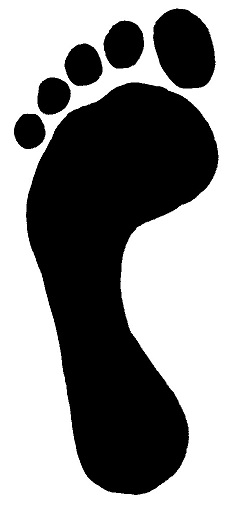
If you suffer from foot, ankle, knee, low back pain, or related problems including shin splints, bunions, heel spurs, plantar fasciitis, ‘fallen’ arches, or Achilles tendonitis, then this article should be of particular interest to you. Your feet may be holding you back from becoming stronger.
The feet are the body’s base of support. During exercise, sport, and most daily activities, force enters the body through your hands and feet, with the feet supporting the bulk of this workload. However, whereas most people understand the importance of grip training and how strong hands contribute to a strong upper body, our feet are often neglected. Most people just shove their feet into rigid dress shoes or ‘bouncy’ running shoes and forget about them.
To make matters worse, when our feet start to hurt we are typically advised to wear rigid orthotics or “ultra-supportive”, inflexible shoes to help support our feet. Unfortunately, binding up your feet like this interferes with or even eliminates their ability to move. Less movement (or poor movement) leads to more weakness.
Orthotics are like crutches… they may take the pressure off while you are using them, but they do not correct the underlying weakness. If you had weak hands or sore wrists would you start wearing wrist wraps and rigid hand splints every day? I hope not. You would perform mobility and strengthening exercises to restore proper function to your hands. Well, your feet typically weight bear all day long, which makes it even more crucial to focus on strengthening their weaknesses rather than “bracing” them externally!
In this article I’ll be introducing you to exercises and footwear that can help you “fix” your feet, heal old injuries, improve your posture, and start moving better in general. Also take a few minutes to watch my recent interview (below) with Steven Sashen, barefoot runner and the founder of Xero Shoes® (a modern spin on the traditional barefoot running sandal), where he explains the problem with most “athletic footwear”
We discuss several important topics related to foot health, including:
- The three key moves that let you easily and comfortably run barefoot
- Why “minimalist” shoes are not the same as barefoot (so if you tried minimal and it didn’t work, here’s why)
- How being barefoot can help if you have ankle, knee, hip, back, or even neck pain… and plantar fasciitis
- The “foam mattress” theory about why cushioning and orthotics may be harming you.
Watch the video of our interview here:
Check out the other related articles and videos on his website at XeroShoes.com. (When you get there click on Discover Your Feet!)
Your feet were designed to move, which is why they have so many joints! Each foot has 33 muscles, 26 bones, and hundreds of sensory receptors, but most of us just treat them like pieces of meat attached to the bottom of our legs. Stimulating and exercising your foot muscles will improve both your strength and balance.
Footwear
The fact is that most modern footwear may cause more problems than they correct. First of all, most major shoe companies include a rigid mid-foot and all types of cushioning systems in their running shoes (such as “Super Springs”, “Motion Control”, “Shox”, or “Air”) which are intended to reduce impact forces. However, the science behind most of these designs is questionable at best (1, 7) .
The truth is that proper running biomechanics rule out the need for a well cushioned heel in a shoe. First of all, if your heel is hitting the ground first, then you are not using correct running technique. Secondly, during an effective push-off when your foot contacts the ground it will transfer the forces absorbed by the muscles back into the ground. In fact, your body gets a lot of information from these ground forces.
Excessive cushioning reduces the amount of information (neural muscular signals) that your body receives through the feet, and you will lose a certain percentage of strength and flexibility as a result. These shoes also create a problem when it comes to lifting weights. When you perform ground-based exercises such as deadlifts, squats, lunges, Olympic lifting or jumping exercises, you need to apply force into the ground through your feet to move the weight.
What happens is this cushiony athletic footwear ends up “absorbing” the force rather than transferring it from your feet to ground. This makes your training very inefficient. Your feet must be allowed to move and flex naturally to stay healthy and strong. They also need to “communicate” with the ground. What this comes down to is wearing as little shoe as possible.
Training with “less shoe” will lead to greater foot movement resulting in stronger feet! Incidentally, wearing gloves can have a similar negative effect on your training by dampening the pressure signals your hands receive from the weights. Most high level athletes understand this. Elite level wrestlers, gymnasts, mixed martial artists, track athletes, competitive runners and strength athletes all work out with no shoes or flat shoes that have minimal support, as do a growing number of other athletes.
Regrettably many health and fitness professionals still argue against this, insisting that expensive “high-tech” shoes are better for your feet. Unfortunately, many people prefer to stick with the information that they have become comfortable with rather than introduce themselves to different perspectives.
Science tells us some of the many other benefits of training in bare feet:
- Plantar skin surfaces thicken with barefoot activity, which protects the foot and reduces risk of injury. For example, a lower risk of plantar fasciitis is associated with barefoot activity (2, 3) .
- Plantar surface sensory feedback is much higher in bare feet compared to when wearing shoes, which is very important for balance and efficient locomotion (4) .
- Barefooted activity reduces impact loading by allowing for deflection of the longitudinal arch of the foot and promoting greater knee flexion during walking and running (3, 5, 8) .
- Barefoot activity encourages better alignment of the toes with the metatarsal bones and more “grasping” of the surface with the toes (6, 2) .
- Barefoot activity stimulates the intrinsic muscles of the foot, which can increase the arch of the foot in individuals with a reduced arch (4) .
- A study by the American Academy of Physical Medicine and Rehabilitation found those running in trainers (shoes) have 36% more knee twisting and 54% more hip twisting than those who ran without shoes.
To summarize, these benefits include optimal development of the arches of your feet, better alignment of your toes, strengthening of the intrinsic muscles of your feet, better balance, less risk of injury, and more efficient locomotion. If you are an athlete, the benefits of barefoot training are extremely important. Time off training due to foot, toe, and ankle problems could have been avoided if more time were dedicated to barefoot activity.
Should I Start Training Barefoot Immediately?
It might not be a good idea to start running or working out in barefeet right away. Due to restriction of movement, lack of exercise and minimal stimulation your feet have likely become very weak. Years of wearing tight, restrictive, binding, cushiony shoes will put your feet to “sleep” and lead to atrophy of your foot muscles. You need to gradually strengthen your feet and slowly introduce them to greater range of motion.
Walking barefoot for short periods of time around the house or in your back yard is a great way to start… plus it feels good! If you have access to a beach or a well manicured lawn, slowly progress from walking barefoot for a few minutes at a time and working up to a longer duration, before introducing any more challenging barefoot activities.
For walking outside on solid surfaces such as concrete or uneven terrain, I suggest you wear appropriate footwear that will provide minimal support while still allowing for greater natural movement of your feet. The following is a list of footwear I recommend. Again, the key is to wear as little shoe as possible:
Nike Free – OK
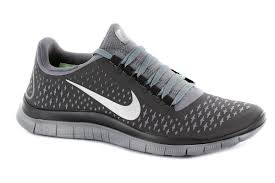
Converse Chuck Taylors – Good
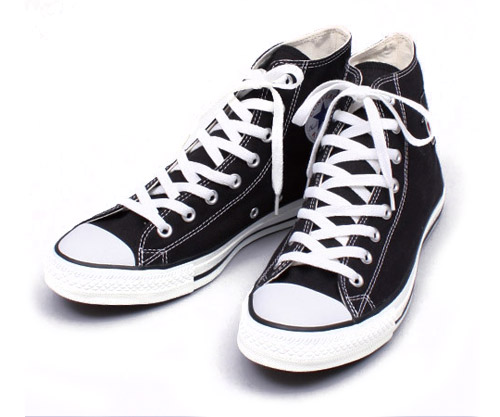
Vibram Five Fingers – Very Good
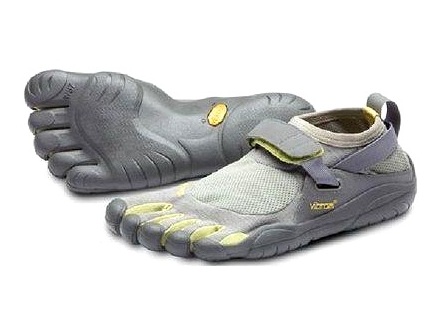
Xero Shoes – Awesome!
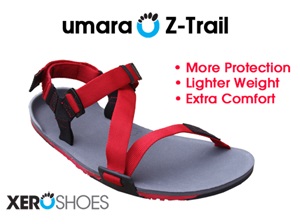
^^ Click Image to Learn More^^
Human Body (bare feet) – Best
So literally, we want as little shoe as possible. Above all, when it comes to your footwear, think function rather than fashion.
One might think that it would make sense to gradually progress from wearing Nike Free to Vibrams and then to Xero Shoes before attempting to train in bare feet. However, even minimalist footwear can still interfere with the natural movement of your feet.
Yes, there certainly is a benefit to wearing footwear that allows more free movement with less restriction or cushioning, but as Steve explained in the video interview above, the best is to simply start walking around in bare-feet for a few minutes at a time and gradually progress to a longer duration without shoes as your feet adapt and get stronger. Then you can gradually start to introduce other barefoot activities such as lifting weights or running. If you’re working out or running outside I recommend wearing a pair of Xero sandals simply to protect your feet while allowing them to move “naturally”.
Watch my Xero Shoes Product Review here:
What About Training Your Feet?
OK, so orthotics, arch supports, and rigid or “cushiony” shoes are out. But your feet are still sore and weak! Is there anything else you can do about it? Yes, you can actually train your feet just as you can any other muscle group.
In fact, some of my clients have experienced fantastic results by training their feet, including a significant increase in overall strength and mobility! Some of the exercises I use to train my clients foot and lower leg muscles are listed below:
1. Start walking barefoot or in barefoot footwear like Xero sandals:
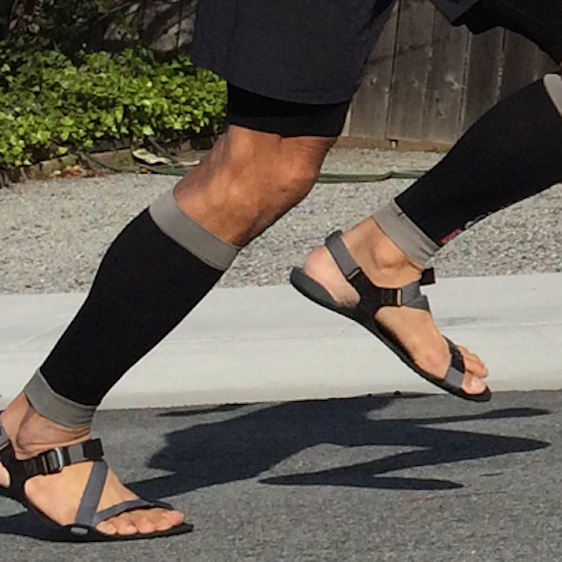
As I have already discussed, you can strengthen your feet by introducing shoes that allow greater mobility and by simply walking and exercising barefoot. Many people describe how barefoot walking and running has improved their mobility, healed old injuries, strengthened their feet and legs, turned flat feet into feet with arches, and much more.
One big worry about being barefoot outside, not surprisingly, is all the stuff on the ground that can hurt and cut your feet, plus all the dirt you have to wash off when you get home. Also most stores and restaurants won’t let you in without some form of footwear.
That’s where Xero Shoes might be “better than barefoot”.
2. Warm Up and Mobility Exercises:
Just as you would warm up any other body part before training, the same applies for your feet. Start with active range of motion exercises such as foot and ankle rotation in both directions, inversion, eversion, flexion and extension.
Also flex and extend your toes fully, holding each position for at least 5 seconds. Finish by walking for several steps on your heels and on your toes.
3. Eversion Isometrics:
- Sit down and place the outside of your foot against a table leg or closed door
- Push outward with your foot into the object your foot is against (your ankle should not move) causing a contraction of your muscles.
- Hold this muscle contraction for 10 seconds,
- Relax for 10 seconds
- Repeat 3 times 4.
4. Inversion Isometrics:
- Sit down and place the inside of your foot against a table leg or closed door
- Pull inward, rotating your foot into the object your foot is against (your ankle joint should not move) causing a contraction of your muscles.
- Hold this muscle contraction for 10 seconds
- Relax for 10 seconds
- Repeat 3 times
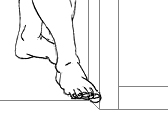 These isometric exercises can also be performed by combining eversion and inversion WITH flexion and extension (plantar-flexion and dorsi-flexion). Basically, you would press your foot down before performing the inversion / eversion exercises, and then repeat with your foot flexed up for both positions.
These isometric exercises can also be performed by combining eversion and inversion WITH flexion and extension (plantar-flexion and dorsi-flexion). Basically, you would press your foot down before performing the inversion / eversion exercises, and then repeat with your foot flexed up for both positions.
5. Toe Grippers:

This exercise is similar to training with a hand-gripper, except with your toes. An inexpensive and simple yet effective method of training your toes is to use foam pedicure toe spacers. You can purchase these foam toe separators in the pedicure section of most pharmacies. You can also use ProFoot Toe Spacers that are specifically designed for this purpose. You place them around your toes with the foam or rubber “fingers” separating your toes, which is how they are meant to be used.
Then you will perform the toe gripping exercise as follows:
- squeeze your toes down onto the foam pad and hold for 5 seconds
- extend your toes up and spread them apart for 5 seconds
- Repeat for 10 to 15 repetitions on each foot.
6. Calf Raises:
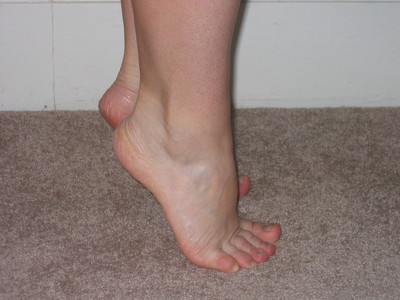
Most people are familiar with this exercise. At first, I would encourage you to perform this exercise without added weight and just focus on strict technique and a strong contraction to properly isolate the muscles involved.
Press yourself up onto your toes and focus on drawing your heels upward toward your calves. Hold this contraction for a couple of seconds, then lower and repeat. As you become stronger you can work on one leg at a time. Perform 3 sets of 10 to 15 repetitions.
7. Reverse Calf Raises (Tibialis Toe Taps):
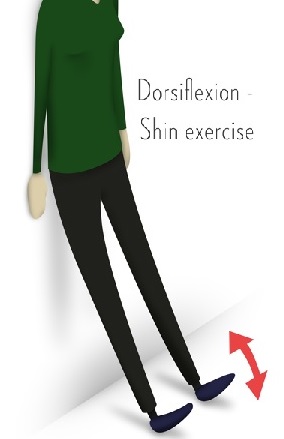
This exercise is less common but equally important. Begin by leaning back against a well or on an exercise ball against the wall (to help you glide up and down more easily) with your feet slightly in front of you.
Keep your knees extended, and slowly raise the front of your feet up (dorsiflex) while focusing on driving your heels down into the ground.
This movement is essentially the opposite of the calf raise. You should feel the muscles in your shins contracting (tibialis anterior).
Perform 3 sets of 10 to 15 repetitions.
8. Acupressure Stimulation:
Stimulating the soles of your feet using an acupressure product such as the MiniAcuball can help to restore circulation and wake up the muscles in your feet. I find this particularly useful in the mornings.
Just remember to apply light pressure to the ball while rolling your foot over it… your goal is to stimulate NOT annihilate your feet! Deep tissue work is not what you need at this point.
Conclusion
Your feet are integral to athletic performance, full body strength, mobility, and good health. Start taking better care of your feet by choosing the appropriate footwear and training them as you would any other lagging body part. By following the advice in this article you will develop stronger, healthier, more flexible feet and will most likely notice a significant improvement in every other ground based activity you perform.
Now that’s taking a step in the right direction!
REFERENCES:
1. Richards C E, Magin P J, Callister R. Is your prescription of distance running shoes evidencebased? British Journal of Sports Medicine. 43: 159-162. 2009.
2. Robbins SE, Gouw GJ. Athletic Footwear and Chronic Overloading. Sports Med: 9(2):76- 85.1990.
3. Robbins SE, Hanna AM. Running related injury prevention through barefoot adaptations. Med Sci in Sports & Exc. 19(2): 148-156. 1987
4. Robbins SE, Gouw GJ, Hanna AM. Running-related injury prevention through innate impact moderating behaviour. Med Sci in Sports & Exc. 21(2):130-139.1987.
5. Robbins SE, Gouw GJ. Athletic Footwear: unsafe due to perceptual illusions. Med Sci in Sports & Exc. 23(2):217-224.1991.
6. Robbins SE, Gouw GJ, McClaran J, Waked E. Protective Sensation of the Plantar aspect of the foot. Foot and ankle. 14(6):p347-352. 1993.
7. McDougall C. The painful truth about trainers: Are running shoes a waste of money. 2009.
8. Lieberman D. Biomechanics of Foot Strikes and Applications to Running Barefoot or in Minimal Footwear. Harvard University. 2010
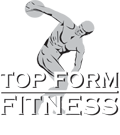
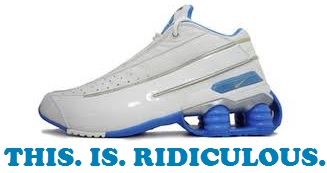
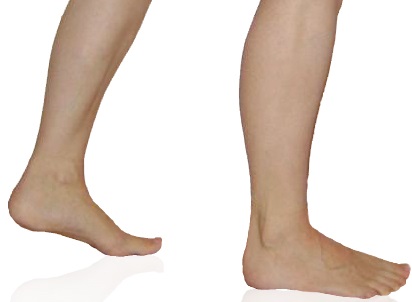
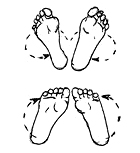
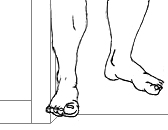
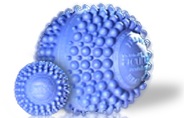
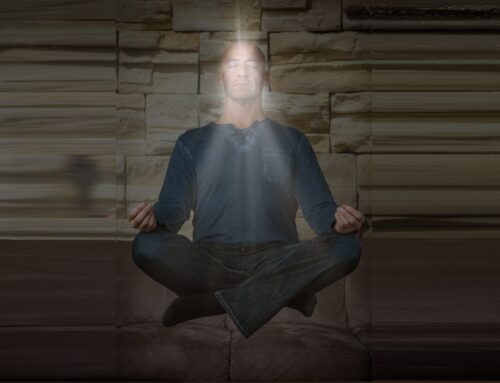
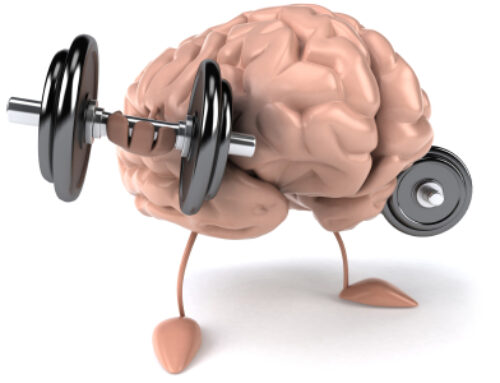
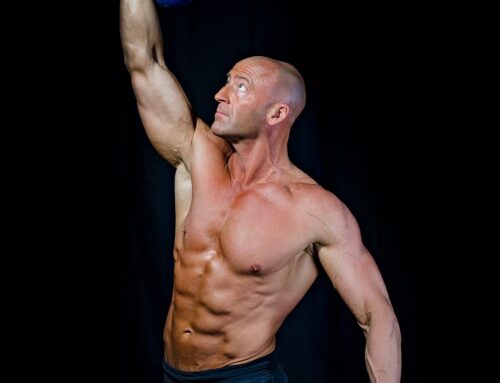
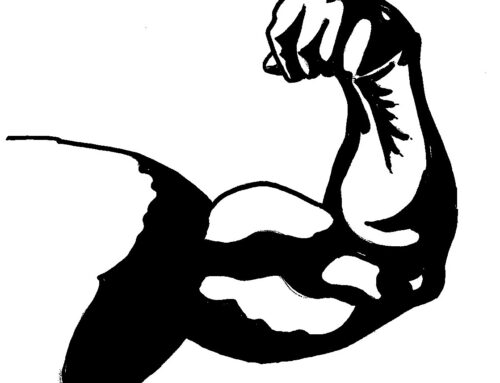
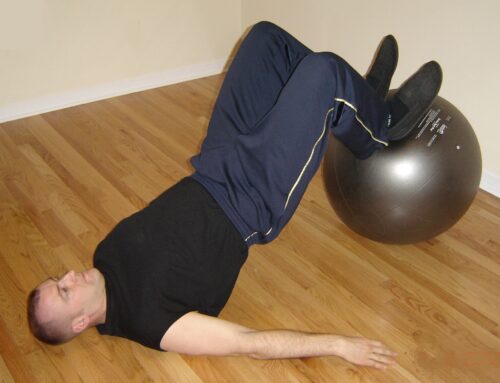
[…] => Fixing Your Feet Can Improve Full Body Function […]
[…] How to Fix your Feet – The Benefits of Barefoot […]
I don’t think people realise that the health of your feet is the gateway to general musculoskeletal health throughout the entire body. Nice insight, and I think I’ll try a couple of those exercises for sure. Acupressure Stimulation sounds like it could actually be quite therapeutic!